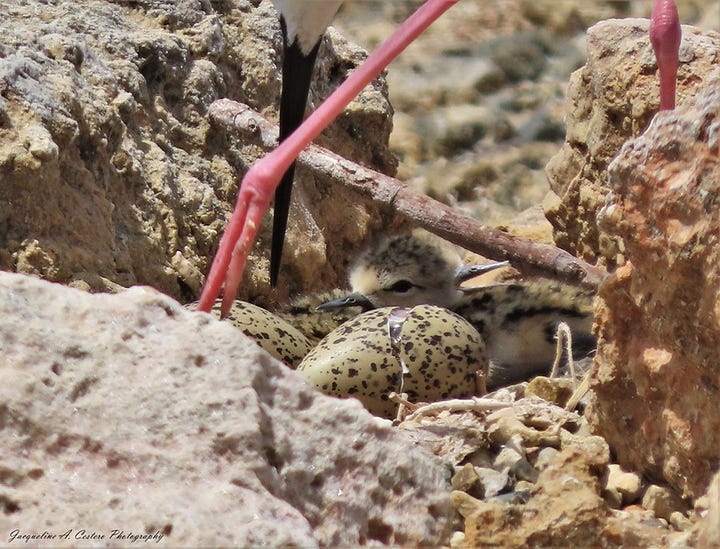It is summer in Anguilla and nesting season for several bird species is underway.
One of my favorite shorebirds is the Black-necked Stilt. This resident bird is seen at almost all of our salt ponds year-round.
A two-toned body, long black bill, and striking pink legs are important field markers for this bird. At first glance, it may be difficult to tell the difference between the sexes of this species. The female has brown wings while the male is black. It is easy to capture this difference in the bright sunlight.
Black-necked Stilt courting and nesting activities are visible from April through July. The mating ritual has the male preening and circling the female several times while she awaits the moment. (This moment was interrupted by other birds, but you get the idea.)
The complete process is described here:
“Black-necked Stilts are especially animated during the breeding season, when females select males for mating. Just before mating, the female stretches out the neck and preens; the male faces her and does the same. Both dip the bill in the water and preen the breast, and this action becomes increasingly frenzied, with much splashing just prior to copulation. Afterward, the pair crosses their bills and runs together for a few steps.”
The nest site is selected and prepared, by both adults just before egg laying. The site is generally elevated and may be fortified if water levels rise. On our wetlands, rock walls are often used as nest sites. Small pebbles mark the outer edge of the nest cup.
Four olive-colored speckled eggs are laid. The markings on the eggs may be variable.
Birds of the World gives us the following insights about the roles played by the parents during the three to four-week incubation period:
“Both sexes take turns incubating day or night (Grant 1982a, Sordahl 1996b; Hawaiian Stilt, Woodside 1979b, Coleman 1981). In very hot environments, incubation behaviors serve to cool eggs rather than to warm them. Parents soak belly feathers in water before sitting on nest to facilitate evaporative cooling and to maintain nest humidity, and periods off nest are reduced to minimum (not observed for Hawaiian Stilts, Coleman 1981). Due to belly soaking, eggs often become encrusted with salt and mud.”
“Male and female usually alternate throughout day; incubation bouts become shorter as shaded ambient temperature increases (Grant 1982a). Sexes equally likely to be incubating at any time (James 1991b; Hawaiian Stilt, Coleman 1981).”
“During changover, relieving bird alights in water near nest and walks toward incubating individual. On approach of relieving bird, incubating bird stands and walks toward water. Occasionally departing bird tosses bits of material similar to nest lining over its back as it leaves the vicinity of nest (Hamilton 1975b; Hawaiian Stilt, Coleman 1981).”
Both parents defend the nest with loud vocalizations and may attack other birds (or humans) who get too close.
I was lucky to observe the nest in the photograph above throughout the incubation period. Even more exciting was watching the third chick hatch from its egg!
When I arrived for my daily nest check a large crack was visible in the third egg. Two chicks had previously hatched and were in and out of the nest.


Over the next hour, I was witness to the birth of a tiny wet chick with both parents attentive to its needs.


While chicks begin to vocalize inside the egg about 3 days before they hatch, the hatching takes place over twenty-four hours. I was lucky to catch it at just the right time!
The other chicks visit the nest regularly and often spend time under a parent until the final egg hatches.
Once dry, our little newborn found refuge under mom’s wing providing another adorable moment in birding on Anguilla.
The companion video provides some of the live-action I experienced throughout this process. You can even witness the removal of the shell after hatching.
In part two of this series, I will explore the next stages of development for these little ones. Yes, there is more to come with these beautiful birds.
Take a walk on the wild side!













I love black-necked stilts, and you have captured some wonderful parts of their parenting lives! Thank you so much for sharing the joy 😊
Wonderful post & video, especially the babies poking around - so cute! 🐣 Thanks for bringing that to us, Jackie❣️